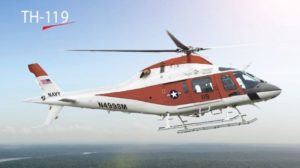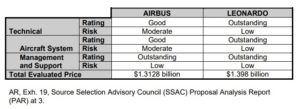This week, the Government Accountability Office (GAO) outlined why it denied Airbus’ protest of the Leonardo‘s win to build the next Navy helicopter trainer aircraft while revealing Leonardo’s offer was more expensive.
Last week, the GAO denied Airbus’ protest of Leonardo’s AugustaWestland win to produce the TH-32A Advanced Helicopter Training Systems. The initial contract is worth $176 million to produce 32 aircraft, although the Navy plans to eventually procure 130 helicopters to replace the existing fleet of TH-57 Sea Rangers by 2023 (Defense Daily, May 14).

The AugustaWestland single-engine TH-119 winning design will become the TH-32A and used for the advanced undergraduate helicopter pilot training systems program. These aircraft will be used to train all Navy. Marine Corps, and Coast Guard rotorcraft pilots.
Airbus pitched the twin-engine H135 while third competitor Bell [TXT] offered its single-engine 407GXi.
In a report released May 18, GAO said Airbus challenged the Navy’s evaluation of the offerors’ technical proposals and alleged the service engaged in disparate treatment between the offerors.
The GAO report said Airbus primarily argued the Navy “unreasonably and disparately evaluated the offerors’ technical proposals under the aircraft system subfactor” and challenged the source selection decision as unreasonable and based on a flawed technical evaluation. However, GAO said it finds no basis to sustain these complaints.
The office said any contracting agency’s evaluation of technical proposals is primarily the responsibility of that agency since they define their needs and identify the best way to accommodate them. GAO does not reevaluate proposals but determined if the contracting agency’s judgment was reasonable and in accord with the stated evaluation criteria and relevant rules and laws.
The offerors were evaluated on both technical and price factors, with the Request For Proposals (RFP) stating the technical factor is significantly more important than price. Technical was split into subfactors of aircraft system and management and support while given both technical ratings and risk ratings.
Technical rating assessed compliance with the solicitation requirements and considers the benefits and detriments related to program performance and operations. Risk rating assessed the risk associated with the technical approach in meeting the requirement.
The GAO report revealed Airbus’ dual-engine offer was cheaper at $1.31 billion total compared to Leonardo’s $1.398 billion for a single-engine aircraft. However, Leonardo exceeded Airbus’ rating in several ways. On technical factors Airbus was rated as good with moderate risk while Leonardo rated outstanding with low risk; on aircraft systems Airbus rated good with moderate risk and Leonardo rated outstanding with low risk; and in management and support both companies tied with outstanding rating and low risk.

GAO said of the five elements making up the aircraft systems factor the RFP noted overall compliance and instrument training would be emphasized over navigation training, warfighting skills training, and safety. The solicitation also told offerors the Navy would evaluate written proposals in conjunction with the system performance evaluation.
The report said under aircraft systems the Navy assigned a significant weakness to Airbus’ autorotation factor and weaknesses to mission profile on low-side emergency procedure and cockpit controls and display. The Navy also assigned Airbus’ proposal eight risk reducers under the compliance element, a strength for the warfighting skills training element, and strength for the safety element.
In contrast, Leonardo was assigned five risk reducers under overall compliance and one strength each for instrument training, navigation training, warfighting skills training, and safety elements.
Airbus argued the Navy’s weakness ratings “are unreasonable and contrary to the solicitation…the protestor also contends the agency should have identified additional strengths and risk reducers in Airbus’s technical proposal under various elements of the aircraft system subfactor.”
However. GAO noted the Navy argued it reasonably assigned the weaknesses, strengths, and risk reducers based on the proposals and RFP requirements.
Airbus also argued the Navy “engaged in disparate treatment when evaluating proposals under the aircraft systems subfactor.”
However, GAO said it finds no basis to question the agency’s assessments. “Although Airbus may disagree with the agency’s judgments in this regard, on this record, the protester failed to establish that those judgements were unreasonable.”
“Furthermore, the record here shows that Airbus and Leonardo offered unique solutions to address the requirements under the instrument training element. The fact that only Leonardo was assessed a strength under this element does not reflect an evaluation error, but rather, it highlights the substantive differences between the two proposed solutions,” the report said.
GAO said since the proposed approaches were substantially different, they were not evaluated in a disparate manner.
“Based on our review of the record, we find that the protester’s allegations are without merit,” the report said.